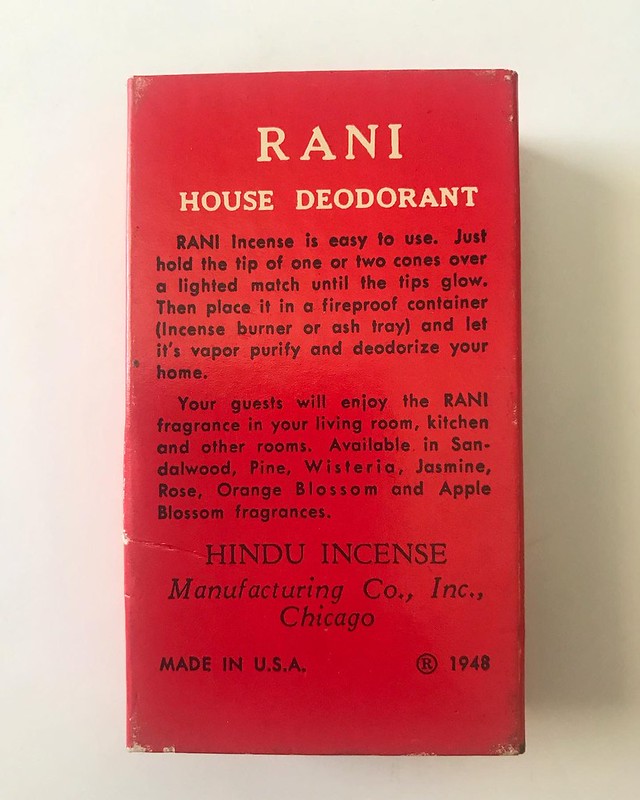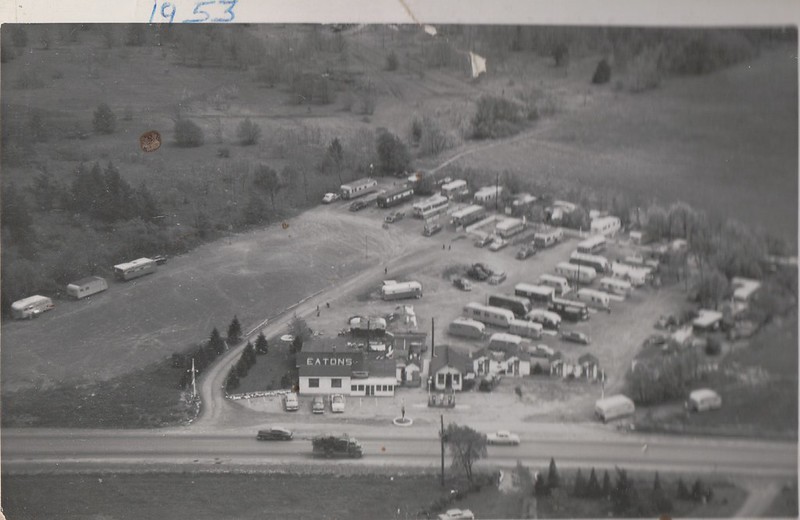Blue tones with spots of warmer colors.


Both my parents were born during the 19-teens and weren’t what you’d call “hippies.” We had something associated with hippies, though — incense. RANI incense cones, to be precise, usually pine. Gift? Sale? I don’t know, but my mother liked them even if we used them sparingly. I’ve continued the tradition, buying incense (if not RANI) sporadically over the years.
Something made me think of RANI, so I looked up images of the box and found RANI, marketed as “house deodorant,” came from Chicago 60616. According to the trademark database the Hindu Incense Manufacturing Co. , Inc., was located at 2620 South Dearborn St. Office? Factory? I may never know. Sadly, today it’s a vacant lot. You can sometimes find the remaining boxes for sale on sites like eBay and Etsy.



More about the RANI mark:
Word Mark RANI
Goods and Services (EXPIRED) IC 003. US 006. G & S: INCENSE. FIRST USE: 19270415. FIRST USE IN COMMERCE: 19270810
Mark Drawing Code (5) WORDS, LETTERS, AND/OR NUMBERS IN STYLIZED FORM
Serial Number 71527404
Filing Date July 5, 1947
Current Basis 1A
Original Filing Basis 1A
Registration Number 0500209
Registration Date May 11, 1948
Owner (REGISTRANT) HINDU INCENSE MANUFACTURING CO. CORPORATION ILLINOIS 2620 SOUTH DEARBORN ST. CHICAGO ILLINOIS
(LAST LISTED OWNER) GENIECO, INC. CORPORATION BY CHANGE OF NAME FROM ILLINOIS 200 NORTH LAFLIN ST. CHICAGO ILLINOIS 60607Assignment Recorded ASSIGNMENT RECORDED
Type of Mark TRADEMARK
Register PRINCIPAL
Affidavit Text SECT 15.
Renewal 2ND RENEWAL 19880511
Live/Dead Indicator DEAD
Genieco lead me to the current Gonesh brand website, from which I learned:
In 1923, a Lithuanian immigrant named Radzukinas acquired a small company, The Hindu Incense Company. For business purposes, he changed his name to Radkins and changed the fortune of his small company by dedicating himself to the manufacture of quality charcoal incense cones and incense burners. Laurent Radkins operated the Hindu Incense Company successfully from the 1920s to the 1960s.
In the mid-sixties, the second generation of the Radkins family entered the business and Genieco, Inc. was born. Soon, the product offering was expanded to include incense sticks. The new brand name was GONESH®, named after the Hindu Elephant Boy, the God of Luck. The name Gonesh was trademarked in 1965.
The Chicago-based Hindu Incense Manufacturing Co., Inc., owned and run by a Lithuanian immigrant, marketing made-in-U.S.A. “house deodorant” incense cones to Greatest Generation housewives — a very American American dream.

According to the Hyde Park Herald, Hyde Parkers who don’t have laundry facilities in their house or building now have to go outside the neighborhood for clean clothes.
Harper & 53rd Launder Koin, the last laundromat in Hyde Park, is closing for good on Tuesday.
The property, located at 5230 S. Harper Ave., is being purchased by the University of Chicago. According to co-owner Josh Hwang, Launder Koin’s last day in operation is technically Feb. 28, but “residents should try and get their laundry done before Feb. 26.”
The laundromat has been operating off 53rd Street since 2002, predating large nearby developments like Harper Court. Back then, Hwang was only 13 years old and working at the business for his parents.
Though demand for laundromats has dwindled nationwide in the last decade, Hwang said Launder Koin still services between 500 to 1,200 people a month.
I’ve wondered if I should do a “Relics” post on the institution of the laundromat, but it never seemed to be the right time. After seeing this article in the Hyde Park Herald, I figure the right time is now. The laundromat is on its way to becoming a relic, and may be for many years.
I grew up in a trailer — no dishwasher, no washer, no dryer. My understanding is in the trailer park’s early days the women did the laundry in the building “down front” (the entrance from Rte. 20). There may have been an informal “laundry day” (Tuesday? Wednesday?). The building was shut up by the time I was old enough to peer through its grimy windows and appeared to be junk storage.
Later, my dad, the only licensed driver, took the laundry to a laundromat on South Lake Park Avenue (6000? 6150?) in Hamburg on Saturdays, mostly by himself. I think it was on one occasion when I went with him that a woman asked him, with his shock of almost snow-white hair, about his cute granddaughter. “That’s my daughter,” he corrected her. I’m sure the women at the laundromat looked at him with newfound respect after that.
Winter trips took longer because he had to dry everything at the laundromat. I tried to dry jeans once or twice in winter air, but discovered they could break (tear) when frozen.
In finer weather, the wet clothes and sheets came home so we could hang them on the clotheslines. After a few hours in the breeze, they really did smell great. They also could pick up bird droppings, stains from falling wild cherries, or, worst of all, in late spring, tent caterpillars. Around May a plague of them would infest the cherry trees over the trailer and clotheslines. You hoped to pick them off so you wouldn’t find any, or parts of any, on your clothes or bedclothes later.
I imagine the laundromat could be a social place, with regulars on Saturday morning who exchanged greetings and maybe chat — with no phones or devices to distract them. Of course, you could always step out and go to a nearby store. It wasn’t likely at that time your clothes would go missing.
After I came to the university, I didn’t need to use a laundromat. The dormitory had washers and dryers, and my apartments since have had on-site laundry machines. The first was tough — I lived on the fourth floor, and the machines were on the first. There weren’t enough, so I could go down and up the stairs several times before one was free. It used a quaint honor system. You were supposed to plug the machine you used into an electrical outlet associated with your meter. It was fascinating to me to watch the meter move with the increased load. It wasn’t so fascinating when you found someone else’s laundry running up your meter.
At the next apartment, a studio, the small laundry room was slightly below ground level in the next building, and served at least a couple of buildings. In rain, snow, or cold, I’d have to dress for the weather, carry the laundry through the courtyard and a bit down the street, pass through a gate, go down steps mostly too dark to see in the alley, and hope for the best. Then repeat back and forth until all the laundry was washed and dried. I don’t miss that, especially when the weather was grim. It’s hard to get motivated to go out a half dozen or more times in wind, sleet, rain, snow, etc., especially on a day off. If I could drive and a laundromat had been an option, I’d have used it.
I’ve used laundromats twice in the last ten years that I can remember. The first was in Anna, Illinois, during a visit to Cache River and Shawnee National Forest. The other was in the college town of Geneseo, New York, while in the area to see Letchworth State Park.
The one in Anna was almost empty at maybe 8 p.m.; I recall the one in Geneseo was more crowded mid-day. Both seemed well kept, and the one in Anna gleamed with stainless steel machines.
Sadly, I have never been to the laundromat on 53rd — I’m not sure I knew it was still open. The next closest one is in Kenwood, prominently situated in a a plaza off the 47th Street exit of Jean-Baptiste Pointe DuSable Lake Shore Drive. I haven’t been in there, either, although I would need to wash heavier items there. It gets mixed reviews.
In my dad’s day, the big deal would be to have enough change — lots of change. No credit or debit cards, no Apple Pay, not even paper bills. If the price went up a quarter, naturally my dad grumbled. Inflation! To him and some of his peers, it didn’t seem an insignificant amount of money. “It adds up,” he might say.
Laundromats may not entirely disappear, just get farther and farther apart — like Hyde Park residents having to go six blocks further north into Kenwood. Five hundred to twelve hundred people a month aren’t insignificant numbers for a neighborhood. Some laundromats, like the one in Hyde Park, are family businesses. How long will future generations want to carry on the laundromat business in a rapidly evolving society that values money and technology?
Mr. McGuire: I want to say one word to you. Just one word.
Benjamin: Yes, sir.
Mr. McGuire: Are you listening?
Benjamin: Yes, I am.
Mr. McGuire: Plastics.
Benjamin: Exactly how do you mean?
Mr. McGuire: There’s a great future in plastics. Think about it. Will you think about it?
The Graduate
Substitute “laundromats” and you’ll see what I mean.
I eagerly await the Star Trek “garment reprocessor”/”cleaning processor.”
Worf: Before being allowed to play, he was to put his soiled clothing in the garment reprocessor.
Keiko: One night goes by . . . two . . . a week . . . ten days . . . by now there’s a pile of socks half a meter high!
O’Brien: Come on . . . it wasn’t half a meter.
Keiko: After two weeks I couldn’t stand it any more. I bundled them up and put them in the cleaning processor. And I’m still doing it.

The question is, “than _____”?
(From the other bumper stickers, this is an outdoorsy person/family.)
Even better, from a drone. There are likely a lot of these out there.
I’ve meant to get a GoPro and do something like this from my bike (when I could ride), but this will have to do for now. Not unlike many in Hyde Park, the driver doesn’t recognize stop signs.